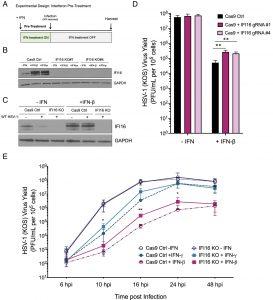Herpes simplex virus (HSV), a widespread infection impacting a vast portion of the global population, lies dormant in the body and periodically resurfaces, causing painful skin blisters. However, in severe cases, HSV can lead to hazardous eye infections, brain inflammation, and life-threatening complications in newborns.
Recent research has provided insight into the interactions between host cells and the virus within the cell’s nucleus, shedding light on the precise mechanisms by which the immune system counteracts HSV, particularly through interferons (Figure 1). This study highlights the critical role of interferons, a group of signalling proteins, in rallying protective molecules to impede the virus’s establishment of infection.

Figure 1: IFI16 reduced replication of WT HSV-1 following IFN pretreatment. (A) IFN pretreatment was performed 20 h prior to infection as diagrammed. (B) Immunoblot analysis of IFI16 protein levels in pretreated Cas9-transduced control and IFI16 knockout cells (n = 3). (C) Immunoblot analysis of IFI16 expression following mock infection or infection of the control and IFI16 knockout fibroblasts with WT HSV-1 KOS (MOI 1, 10 hpi). (D) Viral yields at 16 hpi with the HSV-1 KOS strain (MOI 1) were determined by plaque assay following IFN-β pretreatment (1,000 IU/mL) of the IFI16 knockout and control fibroblasts (n = 3). (E) A time course was conducted following IFN-γ or IFN-β treatment to assess viral yield following HSV-1 (KOS, MOI 1) infection. Statistical significance was determined from at least three biological replicates by two-way ANOVA followed by Tukey’s multiple comparison test. Mean ± SD (error bars), *P < 0.05, **P < 0.01.
The findings pinpoint the action mechanisms of interferon treatments against HSV infections, offering potential insights into therapeutic interventions against herpesviruses and nuclear DNA viruses. Importantly, the study identifies how interferons leverage the host protein IFI16 to counter HSV.
IFI16 plays a pivotal role in blocking HSV replication by encasing viral DNA in a protective molecular shield, preventing gene expression essential for viral multiplication. However, the virus deploys molecules VP16 and ICP0 to dismantle this shield, facilitating its reproduction.
Moreover, IFI16 neutralizes VP16 and ICP0 to impede viral activation. The study uncovers that interferon’s signal boosts IFI16 levels, tipping the scales in favor of the immune system, thwarting viral intrusion into the cell.
This deeper understanding of interferon’s battle tactics against HSV opens avenues for potential treatments by harnessing the mechanisms of action of interferons and IFI16. By deciphering these intricate molecular strategies, the study offers prospects for novel therapeutic approaches against HSV and related viral infections.
Journal article: Sodroski, C. N., et al., 2023. Nuclear interferon-stimulated gene product maintains heterochromatin on the herpes simplex viral genome to limit lytic infection. Proceedings of the National Academy of Sciences.
Summary by Stefan Botha










